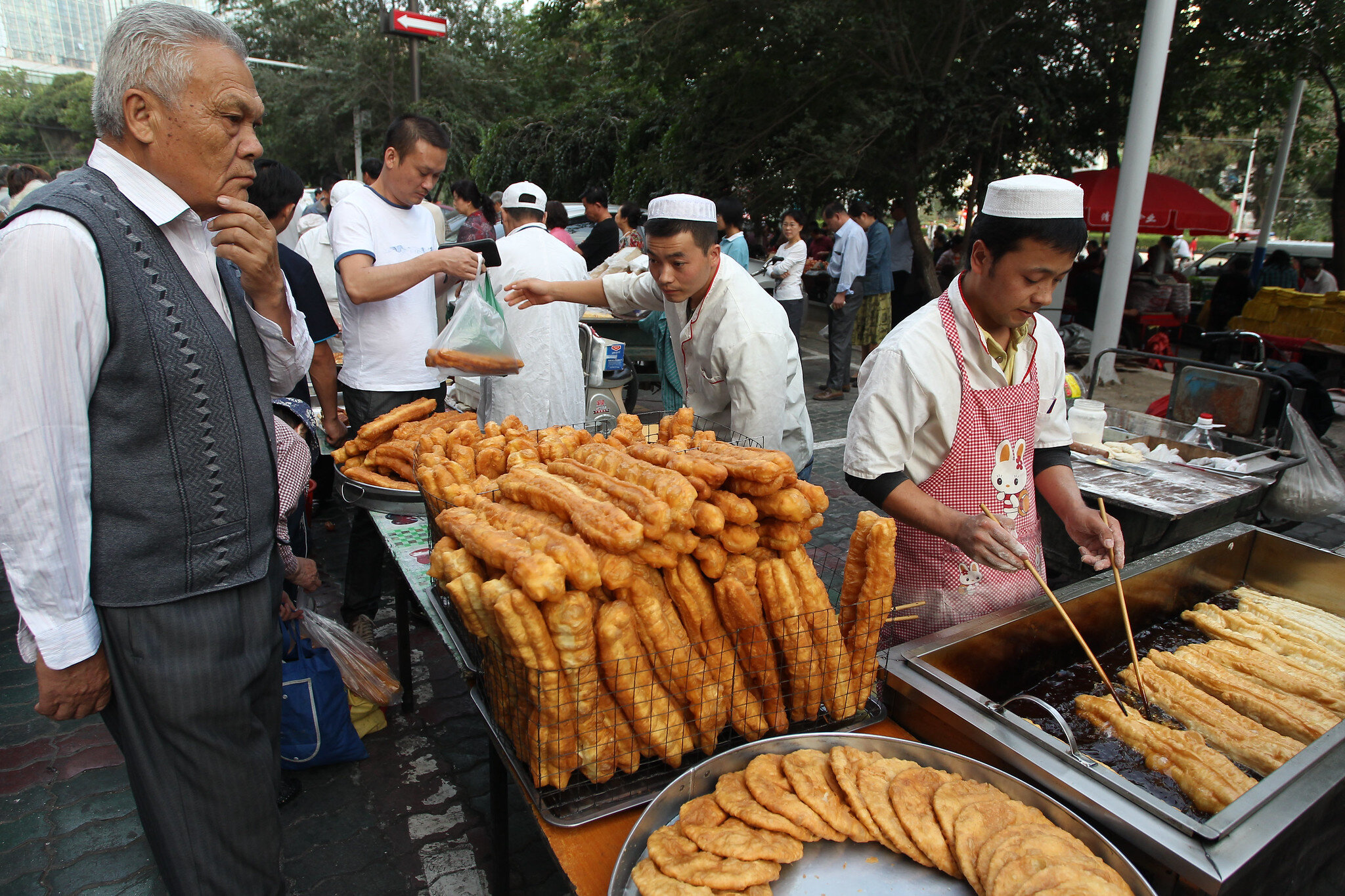From pita bread to lamb, halal Chinese food’s influences stretch from the Mediterranean to Russia and from China to the Middle East.
Street vendors feed crowds with a doughy treat in Urumqi, the capital of China’s Xinjiang Uyghur Autonomous Region. People’s Development Bank. CC BY-NC-ND 2.0.
China has around 23 million Muslims, predominantly made up of the Hui and the Uyghur ethnic groups. Chinese Islam began in 651 A.D., when Islam was first introduced to the country by Arab traders under the Tang dynasty. A diverse array of religions and cultures were brought to Tang China, including Islam, Judaism and Zoroastrianism. However, Islam was the only religion of these to make a lasting impression on the Chinese population. Chinese Islam expanded to different regions and soon developed its own local traditions and foods. The culinary wealth that sprang from Chinese Islamic heritage progressed into popular street foods and dishes still consumed by Chinese people today.
Hui Cuisine
Hui Muslims mostly occupy areas in the Ningxia autonomous region in China’s northwest. Their cuisine is called “qingzhen cai,” loosely meaning “pure truth” in Mandarin. This reflects the widely associated cleanliness of qingzhen restaurants due to their prohibition on smoking and drinking alcohol. Hui cuisine quickly spread across China due to its unique and much-loved flavors.
Close-up shot of aiwowo. Dozen Dessert. CC BY 2.0.
A decadent Hui dessert that remains popular among street vendors is aiwowo, or “love drops.” These small round buns are made of sweet glutinous rice flour and are dusted with a blend of sesame seeds, sugar and walnut kernel chips. Though aiwowo’s inspiration is from Hui cuisine, the snack has become a popular roadside treat in Beijing.
Lanzhou beef noodles in a hot and earthy broth. Language Teaching. CC BY 2.0.
Another seminal dish of the qingzhen cai tradition is Lanzhou beef noodle soup. Many consider this soup to be the most famous noodle dish in all of China. The base of this hearty dish is an aromatic beef broth boiled with cumin seeds, Sichuan peppercorns, onions, ginger, star anise and cinnamon. The fresh, chewy hand-pulled noodles are placed in the broth on a bed of beef slices and chili oil.
Uyghur Food
Uyghurs first came to China around the 3rd century A.D., and ruled over their own kingdom in the 8th century in present-day northern Mongolia. Today, Uyghur populations are concentrated in the Xinjiang Autonomous Region in far northwest China. The Chinese government has recently gained notoriety for setting up large-scale prison camps in Xinjiang, with critics calling it a “genocide” and an attempt to entirely wipe out the Uyghur populace.
Uyghurs tend to draw flavors from Central Asian, Middle Eastern and Chinese cuisines. Both the Hui and the Uyghurs base their dining experience around beef and lamb, avoiding pork due to religious purposes.
However, Uyghur foods draw far more on their Turkish influence: baked goods such as girda naan, similar to bagels, are central to their cuisine.
A vendor prepares lamb kebabs on a coal-fired barbecue for a busy night in Xinjiang. S. Tsui. CC BY-NC-ND 2.0.
In Xinjiang’s capital of Urumqi, visitors can find local vendors selling mutton kebabs, which are pieces of sheep flavored with cumin, paprika, salt and pepper, placed on a skewer and seared over smoky charcoal.
Roasted lamb from a halal restaurant in Beijing. Ulterior Epicure. CC BY-NC-ND 2.0.
Perhaps the most famous Uyghur-inspired dish is roasted whole lamb. Rubbed with a spicy menagerie of cumin, salt, ginger and pepper, the lamb is coated with a flour and yolk batter and baked in a special oven for an hour. This dish is considered a luxury that deserves only the highest-quality meat.
Pile of nang in Xinjiang. Umami. CC BY 2.0.
Another famous Uyghur staple is nang, which is reminiscent of naan bread: a flat pancake-like bread made of corn flour, wheat flour or sorghum flour. This is a building block of Uyghur cuisine, as it comes in a multitude of flavors and seasonings, from a savory sesame coating to a buttery sweet glaze.
Chinese halal food is embraced all over China today, as it continues to combine influences from around the world into culinary treats. With the expansion of Hui and Uyghur influences into Chinese food culture, the intermingling of various flavors will only broaden the appeal of this special cuisine.
Heather Lim
recently earned her B.A. in Literatures in English from University of California, San Diego. She was editor of the Arts and Culture section of The Triton, a student-run newspaper. She plans on working in art criticism, which combines her love of visual art with her passion for journalism.







